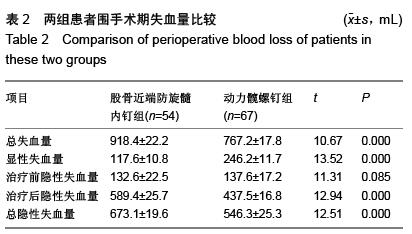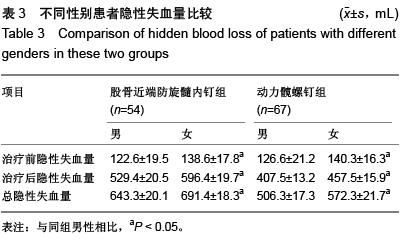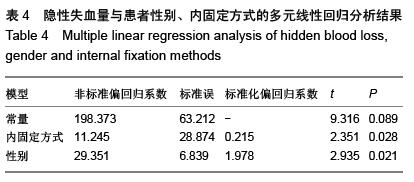| [1] Bohl DD, Basques BA, Golinvaux NS,et al.Extramedullary compared with intramedullary implants for intertrochanteric hip fractures: thirty-day outcomes of 4432 procedures from the ACS NSQIP database.J Bone Joint Surg Am. 2014;96(22): 1871-1877.
[2] McCormack R, Panagiotopolous K, Buckley R, et al.A multicentre,prospective, randomised comparison of the sliding hip screw with the Medoff sliding screw and side plate for unstable intertrochanteric hip fractures.Injury. 2013;44(12): 1904-1909.
[3] Taylor AJ, Gary LC, Arora T, et al.Clinical and demographic factors associated with fractures among older Americans. Osteoporos Int. 2011;22(4):1263-1274.
[4] Swart E, Makhni EC, Macaulay W,et al.Cost-effectiveness analysis of fixation options for intertrochanteric hip fractures.J Bone Joint Surg Am.2014;96(19):1612-1620.
[5] 黎裕明,黄宗贵,戴海,等.切开复位和闭合复位DHS内固定治疗股骨粗隆间骨折临床对比分析[J].医学理论与实践,2015,28(7): 848-850.
[6] Werner BC, Fashandi AH, Gwathmey FW, et al.Trends in themanagementof intertrochanteric femurfracturesin the United States 2005-2011.Hip Int. 2015;25(3):270-276.
[7] 黄诚,付聪聪,黄相杰.DHS和PFNA治疗老年骨质疏松性股骨转子间骨折的临床疗效对比[J].中国矫形外科杂志,2014,22(6): 568-570.
[8] 吴晗,张鉴,李强,等.防旋髓内钉与锁定钢板置入修复高龄股骨转子间不稳定骨折:髋关节功能比较[J].中国组织工程研究. 2015, 19(22):3550-3554.
[9] 章晓云,陈跃平.髋关节形态学研究及其临床意义[J].中国骨与关节损伤杂志.2014,29(12):1300-1302.
[10] Potter LJ, Doleman B, Moppett IK.A systematic review of pre-operative ana-emia and blood transfusion in patients with fracturedhips.Anaesthesia.2015;70(4):483-500.
[11] Li SD,Xu C,Tong PJ.Progress on peri-operative hidden blood loss after hip fracture.Zhongguo Gu Shang.2014;27(10):882-886.
[12] Smith GH, Tsang J, Molyneux SG, et al.The hidden blood loss after hip fracture. Injury. 2011;42(2): 133-135.
[13] Shen L, Zhang Y, Shen Y, et al.Antirotation proximal femoral nail versus dynamic hip screw for intertrochanteric fractures: a meta-analysis of randomized controlled studies.Orthop Traumatol Surg Res.2013;99(4):377-383.
[14] Kumbaraci M,Karapinar L,Incesu M,et al.Treatment of bilateral simultaneous subtrochanteric femur fractures with proximal femoral nail antirotation (PFNA) in a patient with osteopetrosis: case report and review of the literature. J Orthop Sci. 2013;18(3):486-489.
[15] Courtney J, Liebelt D, Nett MP,et al. Hoelsbrekken SE, Opsahl JH, Stiris M, et al.Blood loss and transfusion rates following patellofemoral arthroplasty.Orthop Clin North Am. 2012;43(5):e44-47.
[16] 王军,高明,危杰,等.老年髋部骨折围手术期隐性失血量的相关影响因素分析[J].中华创伤骨科杂志,2015,17(2):143-146.
[17] Dimeski G, Mollee P, Carter A. Increased lipid concentration is associated with increased hemolysis. Clin Chem. 2005;51(12): 2425.
[18] Bao N,Zhou L,Cong Y,et al.Free fatty acids are responsible for the hidden blood loss in total hip and knee arthroplasty. Med Hypotheses.2013;81(1):104-107.
[19] Koessler MJ, Pitto RP.Fat and bone marrow embolism in total hip arthroplasty. Acta Orthop Belg. 2001;67(2):97-109.
[20] Jensen JS.Classification of trochanteric fractures.Acta Orthop Scand. 1980;51(5):803-810.
[21] Cross JB.Estimating allowable blood loss:corrected for dilution. Anesthesiology. 1983;58(3):277-280.
[22] Nadler SB,Hidalgo JH,Bloch T.Prediction of blood volume in normal human adults.Surgery. 1962;57(1):224-232.
[23] O’Connor I, McDowell D, Barnes D.Hip Fractures: The StAnn's Bay Regional Hospital Experience. West Indian Med J.2014; 63(2):142-145.
[24] Cheng Q, Huang W, Gong X, et al.Minimally invasive percutaneous compression plating versus dynamic hip screw for intertrochanteric fractures: a randomized control trial. Chin J Traumatol. 2014;17(5):249-255.
[25] 孙海波,彭阿钦,张万龙,等.PFNA治疗老年股骨粗隆间骨折隐性失血量相关性分析[J].实用骨科杂志,2014,20(7):601-603.
[26] 吴锋,叶劲,邹仲兵,等.动力髋螺钉与股骨近端髓内钉治疗不稳定型股骨粗隆间骨折的临床比较[J].中华关节外科杂志(电子版), 2014,8(3):333-336.
[27] 尚红涛.比较股骨近端防旋髓内钉系统与股骨近端解剖型锁定钢板治疗不稳定型股骨粗隆间骨折的效果[J].中国现代医学杂志,2015,25(6):61-65.
[28] Eberle S, Gabel J, Hungerer S, et al. Auxiliary lockingplate improves fracture stability and healing in intertrochanteric fractures fixated by intramedullary nail. Clin Biomech. 2012; 27(10):1006-1010.
[29] 张磊,柴浩.股骨近端髓内钉与动力髋螺钉固定治疗老年股骨转子间骨折的系统评价[J].中医正骨,2015,27(3):27-31.
[30] 陈穗生,皮佑辉,夏暴权,等.动力髋和股骨近端髓内钉手术治疗股骨粗隆间骨折的系统评价[J].中国矫形外科杂志杂志, 2011, 19(6): 448-451. |
.jpg)



